Temples
Odisha Temple History and Architecture: The landscape of Odisha is dotted with a large number of temples. Odisha is a treasure trove of ancient monuments. The temples of Odisha exhibit a majestic grandeur. Known world over for its architectural wonders, Odisha (Orissa) houses some of the best temples in the country. The temples in Odisha (Orissa) are said to have given supreme expression to architecture. Taking the Kalinga pattern of architecture to its zenith, these Odisha temples are unique in both plan elevation and decoration details.
- Shri Jagannatha Temple
- SUN Temple (Surya Mandira)
- Kakatpur Mangala Temple
- Alarnath Temple
- LingaRaj Temple
- Nilamadhava Temple
- Tara Tarini Temple
- Gupteswar Temple
- Harishankar Temple
- Maa Samaleswari Temple
- Ghanteswari Temple
- Maa Tarini Temple
- Kapilasa Mahadev Temple
- Cuttack Chandi Temple
- Dhabaleswar Temple
- Sri Sri Baladev Jew Temple
- Akhandalamani Temple
- Panchalingeshwar Temple
Shri Jagannatha Temple, Puri
The Jagannath Temple in Puri is a famous Hindu temple dedicated to Jagannath and located in the coastal town of Puri in the state of Odisha, India. The name Jagannath (Lord of the Universe) is a combination of the Sanskrit words Jagat (Universe) and Nath and also, the word "Jagannatha" is evolved from "Jagati" (as an elevated platform or "Ratnabedi" on which the wooden form of Jagannatha, Balabhadra and Subhadra are worshiped on or the temple or its precincts inside the "Narendra Pokhari") and "Natha" (means "Lord"). The temple is an important pilgrimage destination for many Hindu traditions, particularly worshippers of Krishna and Vishnu, and part of the Char Dham pilgrimages that a Hindu is expected to make in one's lifetime.
 The temple was built in the 11th century
atop its ruins by the progenitor of the Eastern Ganga dynasty, King Anantavarman Chodaganga
Deva. The temple is famous for its annual Rath Yatra, or chariot festival, in which the three
main temple deities are hauled on huge and elaborately decorated temple cars. Since medieval
times, it is also associated with intense religious fervour.
The temple was built in the 11th century
atop its ruins by the progenitor of the Eastern Ganga dynasty, King Anantavarman Chodaganga
Deva. The temple is famous for its annual Rath Yatra, or chariot festival, in which the three
main temple deities are hauled on huge and elaborately decorated temple cars. Since medieval
times, it is also associated with intense religious fervour.
Car Festival (Rathayatra)
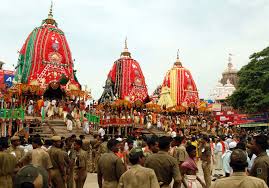 The Jagannath triad are usually worshiped
in the sanctum of the temple at Puri, but once during the month of Asadha (Rainy Season of
Orissa, usually falling in month of June or July), they are brought out onto the Bada Danda
(main street of Puri) and travel (3 km) to the Shri Gundicha Temple, in huge chariots (ratha),
allowing the public to have darśana (Holy view).
The Jagannath triad are usually worshiped
in the sanctum of the temple at Puri, but once during the month of Asadha (Rainy Season of
Orissa, usually falling in month of June or July), they are brought out onto the Bada Danda
(main street of Puri) and travel (3 km) to the Shri Gundicha Temple, in huge chariots (ratha),
allowing the public to have darśana (Holy view).
This festival is known as Rath Yatra, meaning the journey (yatra) of the chariots (ratha). The
Rathas are huge wheeled wooden structures, which are built anew every year and are pulled by the
devotees. The chariot for Jagannath is approximately 45 feet high and 35 feet square and takes
about 2 months to construct. The artists and painters of Puri decorate the cars and paint flower
petals and other designs on the wheels, the wood-carved charioteer and horses, and the inverted
lotuses on the wall behind the throne. The huge chariots of Jagannath pulled during Rath Yatra
is the etymological origin of the English word Juggernaut. The Ratha-Yatra is also termed as the
Shri Gundicha yatra.
SUN Temple (Surya Mandira)
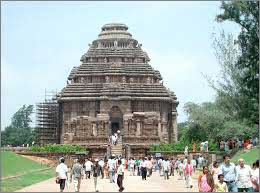 Konark Sun Temple is a 13th century Sun Temple
(also known as the Black Pagoda), at Konark, in Odisha, India. It was supposedly built by king
Narasimhadeva I of Eastern Ganga Dynasty around 1250. It has been built in the shape of a
gigantic chariot with elaborately carved stone wheels, pillars and walls. A major part of the
structure is now in ruins. The temple is a UNESCO World Heritage Site.
Konark Sun Temple is a 13th century Sun Temple
(also known as the Black Pagoda), at Konark, in Odisha, India. It was supposedly built by king
Narasimhadeva I of Eastern Ganga Dynasty around 1250. It has been built in the shape of a
gigantic chariot with elaborately carved stone wheels, pillars and walls. A major part of the
structure is now in ruins. The temple is a UNESCO World Heritage Site.
The name Konark derives from the combination of the Sanskrit words, Kona (corner) and Arka (sun), in reference to the temple which was dedicated to the Sun god Surya. The monument was also called the Black Pagoda by European sailors. In contrast, the Jagannath Temple in Puri was called the White Pagoda. Both temples served as important landmarks for the sailors.
Konark Dance Festival
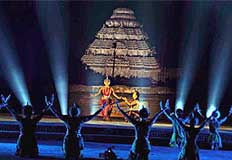 Konark Dance Festival is a dance
festival held every year in December in backdrop of the Sun temple in Konark, Odisha in India.
The exquisite 'Salamander' or the 'dancing hall' of this shrine is an architectural wonder.
Every inch of its walls have been covered with fine artistic designs of the ancient times.
Musicians playing drums, cymbals and other musical instruments adorn the sculptures in Odissi
dance poses.
Konark Dance Festival is a dance
festival held every year in December in backdrop of the Sun temple in Konark, Odisha in India.
The exquisite 'Salamander' or the 'dancing hall' of this shrine is an architectural wonder.
Every inch of its walls have been covered with fine artistic designs of the ancient times.
Musicians playing drums, cymbals and other musical instruments adorn the sculptures in Odissi
dance poses.
Many celebrated dancers from all over the country perform at this
venue. Since 1989, this festival has been organized in the state jointly by Odisha Tourism and
Odissi Research Centre to promote the diverse Indian dance heritage as well as the popularity of
Konark Temple and Odisha as a tourist destination.
Mangala Temple, Kakatpur
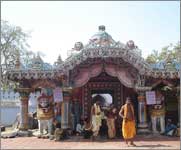 Maa Mangala Temple is a Mangala temple in
Kakatpur, Puri, in the state of Orissa on the eastern coast of India. The temple is built in
typical Kalinga style and is a major pilgrimage for devotees of Shakti cult. Pilgrims frequent
the temple seeking boons from Maa Mangala. There is a bed made of solid stone on which it is
said Maa Mangala rests after touring the entire universe everyday. As if to attest to this, the
bed looks worn out in just the same way it would if it were in use for centuries.
Maa Mangala Temple is a Mangala temple in
Kakatpur, Puri, in the state of Orissa on the eastern coast of India. The temple is built in
typical Kalinga style and is a major pilgrimage for devotees of Shakti cult. Pilgrims frequent
the temple seeking boons from Maa Mangala. There is a bed made of solid stone on which it is
said Maa Mangala rests after touring the entire universe everyday. As if to attest to this, the
bed looks worn out in just the same way it would if it were in use for centuries.
Jhamu Yatra
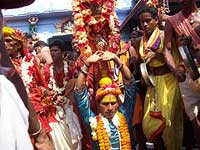 The most popular festival of Goddess Mangala
is 'Jhamu Yatra'. It occurs on the first Tuesday of the Secred month Vaisakh (April 14 to May
15) every year. On that occasion devotees collect sacred water from river Prachi and pray the
deity to get her blessings, then with the earthen pot , filled with sacred water, on their
soldier, they are able to walk on the surface of burning fire spread on a long channel on bare
feet. Due to their faith on Goddess Mangala and their Mother's blessing on them, the devotess
are unhurt and uninjured while perferming such a risky custom. Every year thousands of devotees
come to Kakatpur to celebrate the Jhamu festival.
The most popular festival of Goddess Mangala
is 'Jhamu Yatra'. It occurs on the first Tuesday of the Secred month Vaisakh (April 14 to May
15) every year. On that occasion devotees collect sacred water from river Prachi and pray the
deity to get her blessings, then with the earthen pot , filled with sacred water, on their
soldier, they are able to walk on the surface of burning fire spread on a long channel on bare
feet. Due to their faith on Goddess Mangala and their Mother's blessing on them, the devotess
are unhurt and uninjured while perferming such a risky custom. Every year thousands of devotees
come to Kakatpur to celebrate the Jhamu festival.
Alarnath Temple, Brahmagiri
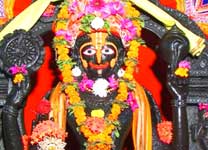 Lord Alarnath temple in Brahmagiri, around
25 km from Puri, is not a big tourist destination but a famous religious place for all Krishna
devotees. It is explained that in Satya Yuga, Lord Brahma came and worshipped Lord Vishnu here
on top of a hill. One day Lord Vishnu appeared and said, "I am very pleased with your worship.
Make a four-armed Deity of Me holding shankha, chakra, gada, and padma (conch shell, disk, club,
and lotus).
Lord Alarnath temple in Brahmagiri, around
25 km from Puri, is not a big tourist destination but a famous religious place for all Krishna
devotees. It is explained that in Satya Yuga, Lord Brahma came and worshipped Lord Vishnu here
on top of a hill. One day Lord Vishnu appeared and said, "I am very pleased with your worship.
Make a four-armed Deity of Me holding shankha, chakra, gada, and padma (conch shell, disk, club,
and lotus).
The Deity should be made from a piece of black stone. Also install a Deity of Garuda". Lord Vishnu also said, "This place will be called Brahmagiri (Brahma's hill) because you have worshipped me here". According to mythology, the rulers of Alwar in Rajasthan had established the temple here. The temple was later known as Alwarnath or Alarnath.
In the temple, Lord Vishnu is worshiped as Lord Alarnath. The deity has four arms. He holds a chakra in his upper right hand, a lotus in his lower right hand, a conch in his upper left hand and a club in his lower left hand. Lord Vishnu’s carrier eagle, known as Garuda, kneels at the feet of the deity with his hands folded in prayer position. The deities of Lord Krishna’s queens Rukmini and Satyabhama are also found inside the temple. Deity of Lord Chaitanya is also found inside the temple.
Lingaraj Temple, Bhubaneswar
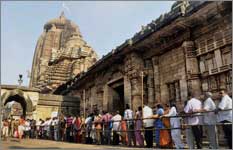 Lingaraj Temple is a Hindu temple
dedicated to Harihara, a form of Shiva and is one of the oldest temples of Bhubaneswar, the
capital of the East Indian state of Odisha. The temple is the most prominent landmark of the
Bhubaneswar city and one of the major tourist attractions of the state.
Lingaraj Temple is a Hindu temple
dedicated to Harihara, a form of Shiva and is one of the oldest temples of Bhubaneswar, the
capital of the East Indian state of Odisha. The temple is the most prominent landmark of the
Bhubaneswar city and one of the major tourist attractions of the state.
Bhubaneswar is called the Ekamra Kshetra as the deity of Lingaraj was originally under a mango tree (Ekamra) as noted in Ekamra Purana, a 13th-century Sanskrit treatise. The temple is active in worship practises, unlike most other temples in Bhubaneswar and Shiva is worshipped as Harihara, a combined form of Vishnu and Shiva.
Car Festival of Lingaraj
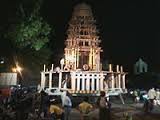 As per Hindu legend, an underground
river originating from the Lingaraj temple fills the Bindusagar Tank (meaning ocean drop) and
the water is believed to heal physical and spiritual illness. The water from the tank is thus
treated sacred and pilgrims take a holy dip during festive occasions. The central deity of the
temple, Lingaraj, is worshipped both as Shiva and Vishnu. The harmony between the two sects of
Hinduism, Saivism and Vaishanvism, is seen in this temple where the deity is worshipped as
Harihara, a combined form of Vishnu and Shiva.
As per Hindu legend, an underground
river originating from the Lingaraj temple fills the Bindusagar Tank (meaning ocean drop) and
the water is believed to heal physical and spiritual illness. The water from the tank is thus
treated sacred and pilgrims take a holy dip during festive occasions. The central deity of the
temple, Lingaraj, is worshipped both as Shiva and Vishnu. The harmony between the two sects of
Hinduism, Saivism and Vaishanvism, is seen in this temple where the deity is worshipped as
Harihara, a combined form of Vishnu and Shiva.
Nilamadhava Temple, Nayagarh
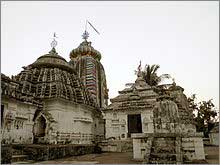 Sri Nilamadhava Temple is very old and
famous Vishnu temple which is near to the bank of Mahanadi,in Kantilo. which is present near to
the twin hills with a surrounding forests. A permanent flow of holy water from the feet of Lord
Nilamadhava. Lord Siddheswar is also present which are the highlights of the place.
Sri Nilamadhava Temple is very old and
famous Vishnu temple which is near to the bank of Mahanadi,in Kantilo. which is present near to
the twin hills with a surrounding forests. A permanent flow of holy water from the feet of Lord
Nilamadhava. Lord Siddheswar is also present which are the highlights of the place.
All initiated in a small cave in the Brahmadri hills situated on the banks of Mahanadi, which is known as Kantilo of Nayagarh district today. Here, Biswabasu the local Sabara Chief worshipped Kitung, as the God was known in the Sabara dialect. According to the Puranas, the deity was originally worshipped in the form of an Indranila gem image known as “Nilamadhava".
Ratha Saptami (Magha Saptami)
Ratha Saptami or Rathasapthami (Magha Saptami) is a Hindu festival that falls on the seventh day (Saptami) in the bright half (Shukla Paksha) of the Hindu month Maagha. It marks the seventh day following the Sun’s northerly movement (Uttarayana) of vernal equinox starting from Capricorn (Makara). It is symbolically represented in the form of the Sun God Surya turning his Ratha (Chariot) drawn by seven horses (representing seven colours) towards the northern hemisphere, in a north-easterly direction. It also marks the birth of Surya and hence celebrated as Surya Jayanti (the Sun-god’s birthday).
Tara Tarini Temple, Ganjam
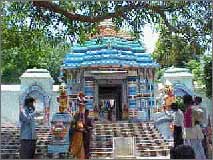 Tara Tarini temple is on the Kumari hills on
the bank of the Rushikulya near Purushottampur in Ganjam District, 30 km from Berhampur, in the
state of Odisha, India. The twin goddesses Tara and Tarini are worshiped at the temple as
manifestations of Adi Shakti. The Taratarini Hill Shrine is one of the oldest pilgrimage centers
of the Mother Goddess and is one of four major ancient Shakti Peethas in India.
Tara Tarini temple is on the Kumari hills on
the bank of the Rushikulya near Purushottampur in Ganjam District, 30 km from Berhampur, in the
state of Odisha, India. The twin goddesses Tara and Tarini are worshiped at the temple as
manifestations of Adi Shakti. The Taratarini Hill Shrine is one of the oldest pilgrimage centers
of the Mother Goddess and is one of four major ancient Shakti Peethas in India.
The mythological texts recognize four major Shakti Peethas: Tara Tarini (Stana Khanda), near Berhampur; Bimala (Pada Khanda) inside the Jagannath Temple (Puri); Kamakhya (Yoni khanda), near Guwahati; and Dakshina Kalika (Mukha khanda) in Kolkata. There are 52 other sacred Shakti Peethas, which originated from the limbs of Mata Sati's corpse in the Satya Yuga.
Chaitra Yatra (Chaitra Mela / Parva)
This Chaitra Parba/Chaitra Mela/Chaitra Yatra is the most important among the festivals,
celebrated at the Tara Tarini Hill Shrine. It takes place on each Tuesday of the month of
Chaitra,[9] i.e., during mid-March to mid-April (according to the English calendar). Lakhs of
devotees come from every corner of world to have darshan of the Tara Tarini and perform their
Manasika after fulfillment of their desires.
Grand congregations take place on the
first, second, third and fourth Tuesdays. On Tuesday, the shrine remains open for the Darshan of
the deities from 1.00 AM (mid-night on Monday) till 11 PM (of Tuesday). During that period,
Pahada (daytime rest) of the deities is confined to night-time only. Devotees come to offer the
first bunch of hair of the newborn babies with the believe that goddesses Tara Tarini will
protect the newborns from all evils and ensure their well-being.
Gupteswar Temple, Jeypore
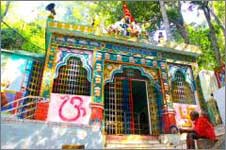 Gupteswar Cave is a city shrine
dedicated to Lord Shiva. It is a world-famous pilgrim site situated about 55 km away Jeypore,
Koraput District in the state of Odisha, India. It is a limestone cave discovered some time ago
and has a number of scenic spots around. The main attraction is the gigantic Shiva Linga which
is said to be increasing in size. Pilgrims from all over the country come here during the
Sravana period, because the yearly BolBom yarta is held in this place.
Gupteswar Cave is a city shrine
dedicated to Lord Shiva. It is a world-famous pilgrim site situated about 55 km away Jeypore,
Koraput District in the state of Odisha, India. It is a limestone cave discovered some time ago
and has a number of scenic spots around. The main attraction is the gigantic Shiva Linga which
is said to be increasing in size. Pilgrims from all over the country come here during the
Sravana period, because the yearly BolBom yarta is held in this place.
Devotees walk
to the Gupteshwar during BolBom yatra to bathe in the maha kund, and then chant near the Shiva
Linga. The cave is more or less like the Bora caves ( India - Odisha and Andhra border ). you
have got same feelings in other natural places . But this Gupteswar cave is special for the
underground water and the view of Davis fall from the farthest end of the cave . It is really
worth seeing. It is a natural cave with Stalagmites. One has to reach the end to view the superb
scene .
Harishankar and Nrusinghanath Temple, Bolangir
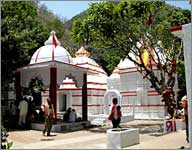 Sri Sri Harisankar Devasthana, in
India, is on the slopes of the beautiful Gandhamardhan hills, Orissa. It is popular for its
scenes of nature and presence of two Hindu lords, Vishnu and Shiva. As a holy place, along with
a beautiful stream passing on the granite bed, it has given some visitors a feeling of peace. On
the opposite of side of the Gandhamardhan hills is the temple of Nrusinghanath. The plateau
between the two temples has been found to have ancient Buddhist ruins, which are considered to
be remnants of the ancient Parimalgiri University.
Sri Sri Harisankar Devasthana, in
India, is on the slopes of the beautiful Gandhamardhan hills, Orissa. It is popular for its
scenes of nature and presence of two Hindu lords, Vishnu and Shiva. As a holy place, along with
a beautiful stream passing on the granite bed, it has given some visitors a feeling of peace. On
the opposite of side of the Gandhamardhan hills is the temple of Nrusinghanath. The plateau
between the two temples has been found to have ancient Buddhist ruins, which are considered to
be remnants of the ancient Parimalgiri University.
Maa Samaleswari Temple, Sonapur
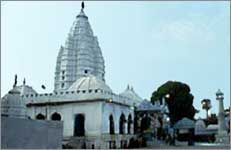 Shree Shree Samaleswari, the presiding
deity of Sambalpur, is a strong religious force in western part of Orissa and Chhattisgarh state
of India. On the bank of the river Mahanadi the mother goddess Samaleswari is worshipped from
ancient times as Jagatjanani, Adishakti, Mahalaxmi and Mahasaraswati. The region in which the
temple is situated has a rich cultural heritage. Sambalpur region is popularly known as
Hirakhanda from ancient times. Ptolemy has described the place as Sambalak, Acording to
Tavernir, the French traveller, and Edward Gibbon, the English historian, diamonds were exported
to Rome from Sambalpur.
Shree Shree Samaleswari, the presiding
deity of Sambalpur, is a strong religious force in western part of Orissa and Chhattisgarh state
of India. On the bank of the river Mahanadi the mother goddess Samaleswari is worshipped from
ancient times as Jagatjanani, Adishakti, Mahalaxmi and Mahasaraswati. The region in which the
temple is situated has a rich cultural heritage. Sambalpur region is popularly known as
Hirakhanda from ancient times. Ptolemy has described the place as Sambalak, Acording to
Tavernir, the French traveller, and Edward Gibbon, the English historian, diamonds were exported
to Rome from Sambalpur.
Ghanteswari Temple, Chipilma
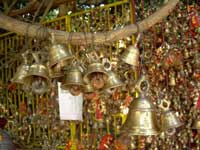 Maa Ghanteshwari temple is a temple
in the district of Sambalpur, the western region of Orissa, India. As the name suggests there
are bells everywhere. People offer bells to goddess Ghanteswari or the Deity of Bells, after
fulfillment of their wishes. A large number of pilgrims from across the state visit the temple.
It is known as the 'lighthouse without light', built by the early sailors, for whom the bells
served as warning against heavy winds. The special significance of this place lies in the great
number of small bells hanging all around.
Maa Ghanteshwari temple is a temple
in the district of Sambalpur, the western region of Orissa, India. As the name suggests there
are bells everywhere. People offer bells to goddess Ghanteswari or the Deity of Bells, after
fulfillment of their wishes. A large number of pilgrims from across the state visit the temple.
It is known as the 'lighthouse without light', built by the early sailors, for whom the bells
served as warning against heavy winds. The special significance of this place lies in the great
number of small bells hanging all around.
Maa Ghanteshwari Temple is situated 33 kilometres (21 mi) southwest of the district capital Sambalpur on the bank of Mahanadi River. The Chipilima Hydro Powerplant is located near the temple on the same riverbank.
Maa Tarini Temple, Ghatagaon
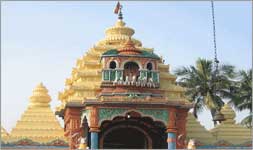 Maa Tarini is one of the embodiments of
Shakti and is one of the chief presiding Goddesses in Oriya culture. Her chief shrine is in
Ghatagaon, Keonjhar District, Odisha. Maa Tarini is the presiding deity for all Shakti and
Tantra peeths or shrines in Odisha. The origin of Shakti or worship of the Earth as a female
embodiment of power is found across many cultures all over the world. In Odishawhich has a high
density of tribal population whose religious practices have been assimilated into the mainstream
Hindu faith, the worship of natural formations such as rocks, tree trunks, rivers is widespread
among the tribes.
Maa Tarini is one of the embodiments of
Shakti and is one of the chief presiding Goddesses in Oriya culture. Her chief shrine is in
Ghatagaon, Keonjhar District, Odisha. Maa Tarini is the presiding deity for all Shakti and
Tantra peeths or shrines in Odisha. The origin of Shakti or worship of the Earth as a female
embodiment of power is found across many cultures all over the world. In Odishawhich has a high
density of tribal population whose religious practices have been assimilated into the mainstream
Hindu faith, the worship of natural formations such as rocks, tree trunks, rivers is widespread
among the tribes.
In this form she is very similar to the conception of the Goddess Kali at Kalighat. Although the two are embodiments of the same divinity, Kali is the Goddess of death and destruction whereas Maa Tarini is the force of life. Interestingly, two of the names of Kali are Maa Tara and Maa Tarini. The famous Hill Shrine of Maa Tara Tarini the breast shrine of adi Shakti in Ganjam district of Odisha represents the force of Both Kali and Tarini and known as Maa Tara Tarini.
Kapilasa Mahadev Temple, Dhenkanal
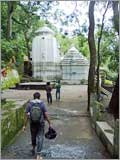 Kapilash Temple is situated in the north eastern
part of Dhenkanal town, Orissa, India at a distance of 26 km from the district head quarters.
The temples are situated at a height of about 2239 feet from sea level. The main tower of the
temple is 60 feet tall. There are two approaches for the temple. One is by climbing 1352 steps
and the other is 'Barabanki' or travelling by the twisting way.King Narasinghdeva I of Ganga
Dynasty constructed the temple for Sri Chandrasekhar in 1246 A.D as indicated in the Kapilash
temple inscription.
Kapilash Temple is situated in the north eastern
part of Dhenkanal town, Orissa, India at a distance of 26 km from the district head quarters.
The temples are situated at a height of about 2239 feet from sea level. The main tower of the
temple is 60 feet tall. There are two approaches for the temple. One is by climbing 1352 steps
and the other is 'Barabanki' or travelling by the twisting way.King Narasinghdeva I of Ganga
Dynasty constructed the temple for Sri Chandrasekhar in 1246 A.D as indicated in the Kapilash
temple inscription.
In the left side of the temple the 'Payamrta kunda'and in the right side the 'Marichi kunda' exist. The temple has a wooden Jagamohana. Sri Ganesh, Kartikeya, Gangadevi, etc. are found in the temple. Patita pavana Jagannath is installed in the temple as the 'Parsa deva'. Lord Vishwanath temple is also situated in Kapilas. According to some scholars this temple is older than the Chandrasekhar temple, hence it is known as 'Budha linga'. There are many legends about Kapilash pitha and its significance. Tradition describes it as the ashram of Kapila, to some scholars it is the second Kailash of Lord Shiva. Shridhar swami who wrote commentary on Bhagavata Purana stayed there. There are some monasteries in the premises.
Cuttack Chandi Temple, Cuttack
 The Katak Chandi Temple is an ancient
temple dedicated to the Goddess Chandi, the presiding deity of Cuttack, Orissa. The temple is
located nearby the banks of the Mahanadi River. It is famous for the annual Durga Puja and Kali
Puja festivals. The Durga Puja festivities are prominent in Maa Katak Chandi temple which takes
place for 16 days stating from dark fortnight of Ashwina Krishna Ashtami till Ashwina shukla
navami and Vijayadashami.
The Katak Chandi Temple is an ancient
temple dedicated to the Goddess Chandi, the presiding deity of Cuttack, Orissa. The temple is
located nearby the banks of the Mahanadi River. It is famous for the annual Durga Puja and Kali
Puja festivals. The Durga Puja festivities are prominent in Maa Katak Chandi temple which takes
place for 16 days stating from dark fortnight of Ashwina Krishna Ashtami till Ashwina shukla
navami and Vijayadashami.
The goddess popularly called as Maa Katak Chandi, sits and rules on the heart of the ancient city.She has four hands holding Paasha(noose), Ankusha(goad), gestures dispelling fear(Abhaya), and granting boon(Varada). She is worshiped as Bhuvaneshvari (the queen of universe) by Sevayatas belonging to Utkala Brahmins everyday. Maa Chandi is worshipped in various incarnations of Durga during the puja. In Cuttack, people strongly believe Maa Katak Chandi as 'The Living Goddess'.
Dhabaleswar Temple, Cuttack
 Dhabaleswar Temple is dedicated to the
worship of Lord Shiva. It is situated at a distance of 37 kilometers from the city of Cuttack,
in the exotic island of Dhabaleshwar. It is one of the famous weekend tours from Cuttack. The
temple, located in an island on River Mahanadi, is embellished with stone carvings that date
back to the early 10th and 11th century. The serene ambiance, in which the temple is situated,
inspires spiritual feeling among one and all.
Dhabaleswar Temple is dedicated to the
worship of Lord Shiva. It is situated at a distance of 37 kilometers from the city of Cuttack,
in the exotic island of Dhabaleshwar. It is one of the famous weekend tours from Cuttack. The
temple, located in an island on River Mahanadi, is embellished with stone carvings that date
back to the early 10th and 11th century. The serene ambiance, in which the temple is situated,
inspires spiritual feeling among one and all.
This section of yours about DHABALESWAR TEMPLE is wrong because the one temple described over here is at Dhauli which is approx 11 km by road South of Bhubaneswar enroute to PURI, but the other famous DHABALESWAR TEMPLE is located in an island within river Mahanadi and is approx 57 km by road North of Bhubaneswar via Cuttack & Choudwar. This information may be incorporated else the information in your section is misleading. There is a wirerope hanging footbridge which accesses to the temple.
Sri Sri Baladev Jew Temple, Kendrapada
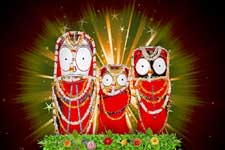 Sri Sri Baladev Jew Temple is one of the
historic temples of Orissa, situated at Ichhapur near Kendrapara. The area covered by the
structure is 2 Acre 6 Decimile. The total area is divided into 2 parts. First part includes
different temples and second part is garden. The boundary wall (Bedha) around the temple is 14
feet high.
Sri Sri Baladev Jew Temple is one of the
historic temples of Orissa, situated at Ichhapur near Kendrapara. The area covered by the
structure is 2 Acre 6 Decimile. The total area is divided into 2 parts. First part includes
different temples and second part is garden. The boundary wall (Bedha) around the temple is 14
feet high.
Aruna Stambha of 40 feet high and 4 feet girth is standing in front of the temple. The Aruna Stambha is also known as “Astapanda” . The height of main temple (Sri Mandir) is 75 feet and width is 40 feet. It is constructed with heavy Baulamalia stone in a traditional 7-step architecture. At the top of the temple, situated the “Ramanandi Chita”, “Brahma Nilachakra” and at the apex, White flag is fluttering restlessly.
Inside the main temple, 3 deities of Sri Baladev Jew, Sri Jagannath and Devi Subhadra are worshipped on a dais named as “ Ratna Simhasana” . Other representative deities are Sri Govinda Jew, Mahalaxmi, Sri Sudarsan, Sri Balgopal and Shalagrama. The middle temple is a bit shorter than the main temple and it is constructed in 5-step traditional architecture. The ancient Garuda Stambha is inside Jagamohan. Sacred Seven Steps are in front of it. Gigantic Stone statues of lion and elephant are situated in front of Batamandir or Mukhashala. Navagraha statues are there also. Sri Patitapaban and Kshetra Rakshak Sri Hanuman are inside Batamandir. Idol of Goddess Tulasi in sitting position is there after the sacred seven steps.
Akhandalamani Temple, Aradi
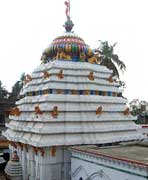 Sri Sri Akhandaleswar Mahadev bije Aradi is
popularly known as Akahnadalamani Mahadev. The temple of the Lord is situated at Aradi which
comes under Chandabali Block, Chandabali Tahasil and Dhusuri Police Station in Bhadrak
Sub-Division of Bhadrak District, Orissa. Akhandalamani Temple at Aradi village, Orissa, India,
is dedicated to Lord Siva. Aradi is about 37 kilometers away from Bhadrak. The present
fifty-foot cement and concrete temple structure replaced a wooden temple some time between
1830-1840 AD.
Sri Sri Akhandaleswar Mahadev bije Aradi is
popularly known as Akahnadalamani Mahadev. The temple of the Lord is situated at Aradi which
comes under Chandabali Block, Chandabali Tahasil and Dhusuri Police Station in Bhadrak
Sub-Division of Bhadrak District, Orissa. Akhandalamani Temple at Aradi village, Orissa, India,
is dedicated to Lord Siva. Aradi is about 37 kilometers away from Bhadrak. The present
fifty-foot cement and concrete temple structure replaced a wooden temple some time between
1830-1840 AD.
Panchalingeshwar Temple, Nilagiri
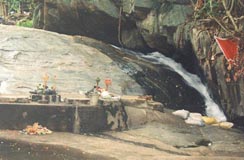 Panchalingeswara Temple is situated on
the hilltop of the Eastern Ghats in Panchalingeshwara, Nilagiri, Baleswar district. It's a
beautiful place for picnic, darshan of Shiva Linga and breath some fresh air from the real
nature. You can hire a car from Balasore/Baleshwara and open your glass while travelling through
the countside road to really feel the actual nature. From Balasore town Your car goes straight
till Sergarh. While travelling the prowdy Swarnachuda Hills of Nilagiri looks foggy and
enchanting. After 12 kms of straight drive you need to take right from Sergarh and go straight
till Nilagairi. There you can stop for a while to taste the mouth watering sweets of at Kuchery
Bazaar, Nilagiri. They are really great.
Panchalingeswara Temple is situated on
the hilltop of the Eastern Ghats in Panchalingeshwara, Nilagiri, Baleswar district. It's a
beautiful place for picnic, darshan of Shiva Linga and breath some fresh air from the real
nature. You can hire a car from Balasore/Baleshwara and open your glass while travelling through
the countside road to really feel the actual nature. From Balasore town Your car goes straight
till Sergarh. While travelling the prowdy Swarnachuda Hills of Nilagiri looks foggy and
enchanting. After 12 kms of straight drive you need to take right from Sergarh and go straight
till Nilagairi. There you can stop for a while to taste the mouth watering sweets of at Kuchery
Bazaar, Nilagiri. They are really great.
Then you can ask anyone the exact route to Panchanlingeswara.Then drive through the country road till the waistline of the hills of Panchanlingeswara. Park your car and start climbing the steps made on the hills to see a panoramic view of the beautiful hill. It's green everywhere except the sky and you. You can smell the freshness of wild flowers and twitter of the winged fauna. A natural bio-reserve of thick flora and exinct fauna could enamore you for a long time. On the top of the hill there is a hill spring. You can wash your hand but not your leg as the water goes and touched Lord Shiva of the temple there. The five round "Shiva Linga" are worshipped as Panchalingeswara (Pancha means five in Odia). The whole pllace is a marvelous arrangement of spirituality and devotoin of God and nature. Bus/Car route- From Balasore/Baleshwar regular bus/car service is available. It's 12 km from Nilagiri town. Rail route- Nearest railroad is at Balasore. From Balasore bus/car service is there. Hotel- There are good hotels available in Balasore town. There is also a Government Panth Nivas available in Panchalingeshwara. You can find a really good picnic spot for your friends and family.
Wildlife
Wildlife Odisha has been the attraction of tourists since ages. Tourists from all over the world come here to visit wildlife sanctuaries in Odisha.
Know More..Beaches
Also famous for its beautiful Odisha beaches, Beaches in Odisha (Orissa) can truly engulf you in a holiday spirit. As you bask in the glory of a moderate sun here, the golden sand beaches leave you still asking for more.
Know More..Tourist Places
One of major attractions is its 500 km long coastline and beaches and natural scenery such as Chilka Lake, Asia's largest brackish water lake.
Know More..